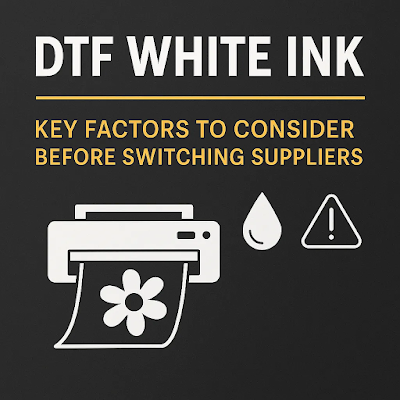Difference Between DTF vs Screen Print Transfers: Explained
In the world of custom apparel printing, there are various techniques available to transfer designs onto fabrics. Two popular methods are DTF (Direct-to-Film) and screen print transfers.
Both techniques offer unique benefits and are suitable for different applications. In this article, we will explore the difference between DTF and screen print transfers, highlighting their process, advantages, and best use cases.
Table of Contents
Introduction
What is DTF?
How Does DTF Work?
Advantages of DTF
Best Use Cases for DTF
What is Screen Print Transfer?
How Does Screen Print Transfer Work?
Advantages of Screen Print Transfer
Best Use Cases for Screen Print Transfer
DTF vs Screen Print Transfers: A Comparison
Conclusion
FAQs
1. Introduction to DTF
Custom apparel has become increasingly popular, and businesses and individuals alike seek efficient and high-quality printing methods. DTF and screen print transfers are two techniques that offer reliable and impressive results. Understanding their differences can help you choose the right method for your printing needs.
2. What is DTF?
DTF, or Direct-to-Film, is a digital printing method that involves printing designs directly onto a specialized film. The film acts as a carrier for the design, which is then transferred onto the fabric.
3. How Does DTF Work?
In the DTF process, a design is printed using specialized DTF ink on a film sheet. The ink used in DTF printing is typically a water-based or eco-solvent ink.
Once the design is printed, a layer of adhesive powder is applied to the ink. This powder sticks to the ink and acts as a bonding agent.
The film with the printed design is then placed onto the fabric, and heat is applied using a heat press machine. The heat causes the adhesive powder to melt and bind the ink to the fabric, creating a permanent and vibrant print.
4. Advantages of DTF
Versatility: DTF can be used on a wide range of fabric types, including cotton, polyester, blends, and even nylon.
Full-color prints: DTF allows for intricate and vibrant designs with rich color reproduction.
High durability: DTF prints are resistant to fading and cracking, ensuring long-lasting quality.
5. Best Use Cases for DTF
Custom apparel: DTF is an excellent choice for personalized garments, such as t-shirts, hoodies, and jerseys.
Complex designs: DTF is capable of reproducing intricate details, making it suitable for designs with gradients, shadows, and fine lines.
6. What is Screen Print Transfer?
Screen print transfer, also known as plastisol transfer, is a traditional printing method that involves creating a design on a screen and transferring it onto a carrier paper.
The design is then applied to the fabric using a heat press machine.
7. How Does Screen Print Transfer Work?
In screen print transfer, the design is first created on a mesh screen using a stencil. Ink is then applied to the screen and forced through the stencil onto the carrier paper.
The carrier paper acts as a temporary surface to hold the design.
To apply the design onto the fabric, the carrier paper is placed on the desired location, and heat is applied using a heat press machine.
The heat causes the ink to melt and adhere to the fabric, creating a permanent print.
8. Advantages of Screen Print Transfer
Consistent quality: Screen print transfers offer consistent and high-quality prints, ensuring accurate color reproduction and sharp details.
Cost-effective: Screen print transfers are a cost-effective option for large orders or bulk printing.
Longevity: Screen print transfers provide excellent durability, making them suitable for garments that undergo frequent washing and heavy use.
9. Best Use Cases for Screen Print Transfer
Sports team jerseys: Screen print transfers are commonly used for printing team names, numbers, and logos on sports jerseys.
Promotional merchandise: Screen print transfers are ideal for producing promotional items like tote bags, caps, and uniforms.
10. DTF vs Screen Print Transfers: A Comparison
Both DTF and screen print transfers have their own merits and are suitable for different scenarios. Here's a quick comparison of their key aspects:
Consider your specific printing requirements, budget, and desired outcomes when choosing between DTF and screen print transfers.
11. Conclusion
In conclusion, DTF and screen print transfers are two popular methods for custom apparel printing. DTF offers versatility, full-color prints, and high durability, making it ideal for personalized garments and complex designs.
On the other hand, screen print transfers provide consistent quality, cost-effectiveness, and longevity, making them a preferred choice for sports team jerseys and promotional merchandise.
Understanding the differences between these techniques will empower you to make an informed decision based on your unique printing needs.
FAQs
Can I use DTF on all types of fabrics?
Yes, DTF can be used on various fabric types, including cotton, polyester, blends, and nylon.
Are screen print transfers suitable for intricate designs?
Screen print transfers are better suited for solid colors and simple designs, rather than intricate details.
Which method is more cost-effective for large orders?
Screen print transfers are more cost-effective for large orders or bulk printing.
Do DTF prints fade or crack over time?
No, DTF prints are highly durable and resistant to fading and cracking.
Can screen print transfers withstand frequent washing?
Yes, screen print transfers provide excellent longevity and can withstand frequent washing and heavy use.




Comments
Post a Comment